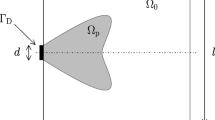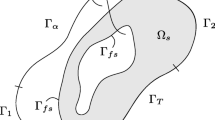The problem of topology optimization of a heat-conducting object for the criterion of uniformity of the steady-state temperature field in an assigned domain was formulated for the first time. To solve the problem, the authors proposed a method of evolutionary topology optimization on the basis of solution of a system of linear equations with a fictitious vector of the right-hand side (heat load). The method is distinguished by the technique of formation of a vector whose components are considered as weight factors. The power distribution function of the weight coefficients was proposed. Selection of the objective function (temperature at the node, average temperature in an assigned domain, and uniformity of the temperature field) is controlled by the vector of the fictitious heat load. The method was tested on three problems: of minimization of the average temperature of a plate with a uniform heat generation, of minimization of the temperature difference in an assigned domain of a square plate, and of optimization of the structure of a mold for vulcanizing an industrial rubber article. The method has shown high efficiency and versatility.
Similar content being viewed by others
References
I. Iatcheva, I. Lilianova, H. Tahrilov, and R. Stancheva, Industrial heating system creating given temperature distribution, Serbian J. Electr. Eng., 5, No. 1, 57–66 (2008).
A. V. Ostroukh et al., Optimization of design and performance characteristics of heating system of press equipment, Am. J. Appl. Sci., 11, No. 6, 939–946 (2014).
R. A. Meric, Boundary elements for static optimal heating of solids, J. Heat Transf., 106, No. 4, 876–880 (1984).
A. N. Diligenskaya and Y. Rapoport, Analytical methods of parametric optimization in inverse heat-conduction problems with internal heat release, J. Eng. Phys. Thermophys., 87, No. 5, 1126–1134 (2014).
S. V. Karpov and S. V. Karpushkin, Determination of efficiency of press molds for industrial rubber product manufacture and system for their heating in vulcanizing press, Chem. Pet. Eng., 48, Nos. 3–4, 153–162 (2012).
E. Tyflopoulos, F. D. Tollnes, M. Steinert, and A. Olsen, State of the art of generative design and topology optimization and potential research needs, Proc. NordDesign 2018, Linköping, Sweden, 14–17 August 2018, Era Digit, Nord (2018), pp. 1–15.
D. J. Lohan, E. M. Dede, and J. T. Allison, Topology optimization for heat conduction using generative design algorithms, Struct. Multidiscip. Optim., 55, No. 3, 1063–1077 (2017).
Q. Li et al., Evolutionary topology optimization for temperature reduction of heat conducting fields, Int. J. Heat Mass Transf., 47, No. 23, 5071–5083 (2004).
S. Wu, Y. Zhang, and S. Liu, Topology optimization for minimizing the maximum temperature of transient heat conduction structure, Struct. Multidiscip. Optim., 60, No. 1, 69–82 (2019).
K. Svanberg, The method of moving asymptotes — A new method for structural optimization, Int. J. Numer. Methods Eng., 24, No. 2, 359–373 (1987).
L. Tang, T. Gao, L. Song, L. Meng, Ch. Zhang, and W. Zhang, Topology optimization of nonlinear heat conduction problems involving large temperature gradient, Comput. Methods Appl. Mech. Eng., 357, Article ID 112600 (2019).
X. Huang and Y. M. Xie, Evolutionary Topology Optimization of Continuum Structures. Methods and Applications, Wiley (2010).
C. S. Edwards, H. A. Kim, and C. J. Budd, An evaluative study on ESO and SIMP for optimising a cantilever tie-beam, Struct. Multidiscip. Optim., 34, No. 5, 403–414 (2007).
A. O. Glebov, S. V. Karpushkin, and E. N. Malygin, Efficiency comparison of topology optimization methods on the example of column press upper beam, Chem. Pet. Eng., 56, Nos. 1–2, 31–41 (2020).
ANSYS Inc. ANSYS 2019 R2 Release, Canonsburg, PA (2019).
A. Gersborg-Hansen, M. P. Bendsøe, and O. Sigmund, Topology optimization of heat conduction problems using the finite volume method, Struct. Multidiscip. Optim., 31, No. 4, 251–259 (2006).
M. P. Bendsøe and O. Sigmund, Topology Optimization, Springer, Berlin, Heidelberg (2004).
V. Subramaniam, T. Dbouk, and J. L. Harion, Topology optimization of conductive heat transfer devices: An experimental investigation, Appl. Therm. Eng., 131, 390–411 (2018).
D. Guirguis, W. W. Melek, and M. F. Aly, High-resolution non-gradient topology optimization, J. Comput. Phys., 372, 107–125 (2018).
P. A. Alekhin, A. O. Glebov, S. V. Karpov, and S. V. Karpushkin, A method for topology optimization results estimation based on the analysis of raster images of the material distribution, Sci. Vis., 11, No. 1, 107–118 (2019).
S.-H. Cha, H.-S. Kim , and S. Cho, Topology design optimization and experimental validation of heat conduction problems, J. Comput. Struct. Eng. Inst. Korea, 28, No. 1, 9–18 (2015).
M. P. Bendsøe, Optimization of Structural Topology, Shape, and Material (1995); https://doi.org/10.1007/978-3-662-03115-5.
O. A. Sigmund, 99 line topology optimization code written in Matlab, Struct. Multidiscip. Optim., 21, No. 2, 120–127 (2001).
D. J. Munk, G. A. Vio, and G. P. Steven, A bi-directional evolutionary structural optimisation algorithm with an added connectivity constraint, Finite Elem. Anal. Des., 131, 25–42 (2017).
A. O. Glebov, S. V. Karpov, S. V. Karpushkin, and E. N. Malygin, Modeling the induction heating of press equipment in an automatic-temperature-control mode, J. Eng. Phys. Thermophys., 92, No. 5, 1130–1141 (2019).
Q. Li, G. P. Steven, O. M. Querin, and Y. M. Xie, Structural topology design with multiple thermal criteria, Eng. Comput. (Swansea, Wales), 17, Nos. 6–7, 715–734 (2000).
Author information
Authors and Affiliations
Corresponding author
Additional information
E. N. Malygin is deceased.
Translated from Inzhenerno-Fizicheskii Zhurnal, Vol. 95, No. 6, pp. 1419–1431, November–December 2022.
Rights and permissions
Springer Nature or its licensor (e.g. a society or other partner) holds exclusive rights to this article under a publishing agreement with the author(s) or other rightsholder(s); author self-archiving of the accepted manuscript version of this article is solely governed by the terms of such publishing agreement and applicable law.
About this article
Cite this article
Glebov, A.O., Karpushkin, S.V. & Malygin, E.N. Designing Devices for Uniform Steady-State Heating with the Method of Evolutionary Structural Optimization. J Eng Phys Thermophy 95, 1393–1405 (2022). https://doi.org/10.1007/s10891-022-02608-6
Received:
Published:
Issue Date:
DOI: https://doi.org/10.1007/s10891-022-02608-6




